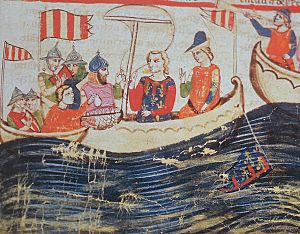Battle of the Gulf of Naples facts for kids
Quick facts for kids Battle of the Gulf of Naples |
|||||||
|---|---|---|---|---|---|---|---|
| Part of War of the Sicilian Vespers | |||||||
 |
|||||||
|
|||||||
| Belligerents | |||||||
| Crown of Aragon | Kingdom of Naples | ||||||
| Commanders and leaders | |||||||
| Roger of Lauria | Charles of Salerno (POW) | ||||||
| Strength | |||||||
| 29 galleys | 28 galleys | ||||||
| Casualties and losses | |||||||
| Unknown | 9–13 galleys captured | ||||||
The Battle of the Gulf of Naples was an important naval battle that took place on June 5, 1284. It happened in the southern part of the Gulf of Naples, near the city of Naples in what is now Italy. This battle was a key part of the War of the Sicilian Vespers, a large conflict happening at the time.
In this battle, a fleet of ships from Aragon and Sicily, led by a skilled commander named Roger of Lauria, fought against a fleet from the Kingdom of Naples. The Neapolitan fleet was commanded by Charles of Salerno, who later became King Charles II. Roger of Lauria's fleet won a big victory, and Charles of Salerno was even captured during the fight!
Contents
The Battle Unfolds
Roger of Lauria knew that Charles of Salerno's allies from Genoa were gathering more ships. He wanted to attack Charles's fleet, which was docked at Naples, before all these enemy ships could join together. Lauria used the darkness of night to sail his ships close to Naples. He even made a few small attacks on the shore. His goal was to make Charles come out of the safety of the port and fight.
A Tricky Plan
The night before the main battle, Lauria's fleet captured two ships. These ships were sent ahead by Charles's father, Charles I of Naples, who was sailing south from Genoa. Charles of Salerno had clear orders to stay in port and wait for his father and allies. However, Charles was known for being a bit impulsive.
Lauria's ships came very close to Naples, tempting Charles even more. Charles's eagerness to fight eventually won over his initial plan to wait. His ships left the port one by one, chasing Lauria's fleet in a very disorganized way.
Lauria's Clever Trap
Lauria pretended to retreat, keeping just ahead of Charles's chasing ships. He led them southward, drawing them closer to about ten of his own ships that he had hidden near Castellammare. Once they were in the right spot, Lauria suddenly turned his fleet around.
He formed his ships into a crescent shape, like a half-moon. The ships that had just joined him were at the back of this formation. Lauria then attacked Charles's fleet from the sides. This was the weakest part of the enemy ships, called galleys.
The Outcome
Charles's fleet was caught off guard. About 15 to 18 of his ships, which were from the Kingdom of Naples, quickly fled back to Naples. This left 9 to 13 ships, which were crewed by French sailors, to be captured. Charles's own ship was the last one to be taken. It only surrendered when Lauria sent divers into the water to try and sink it.
Charles of Salerno was held as a prisoner for several years. He was finally released in 1288, thanks to the efforts of Edward I of England, who helped arrange his freedom.
Ships in the Battle
Here's a simple look at the ships involved in this naval battle:
Aragon-Sicily Fleet (Roger of Lauria)
- About 29 galleys (long, oared warships)
- Some transport ships
- A few smaller vessels
Neapolitan Fleet (Charles of Salerno)
- 15 to 18 galleys from the Kingdom of Naples
- 9 to 13 galleys with French crews
- This made a total of about 28 galleys, possibly a few more.
Images for kids
See also
In Spanish: Batalla naval del golfo de Nápoles para niños


